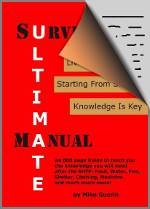Pine Tree Wild Edible Food
 Pine trees are not the first plant that comes to mind when thinking of wild edible plants but actually they can be a great survival food. Pine trees often occupy habitats that are considered lower in available wild foods that your typical hardwood forest but most people will be shocked to discover pine trees actually do have a great benefit to those trying to live off of the land or survive in a survival situation.
Pine trees are not the first plant that comes to mind when thinking of wild edible plants but actually they can be a great survival food. Pine trees often occupy habitats that are considered lower in available wild foods that your typical hardwood forest but most people will be shocked to discover pine trees actually do have a great benefit to those trying to live off of the land or survive in a survival situation.
Most importantly the seeds of allpine species are edible, so no need to learn the identification characteristics of each species. The pine nuts are located at the base of each scale of the pine cones, so one pine cone will contain numerous nuts. To get to the nut you will have to open the pine cone. Some cones like the Jack Pine of the northwest only open under fire conditions. Most open as they dry. So the best technique is to heat the pine cone either by setting them near a fire or any method to speed up the heating/drying process.
Most pine trees have small seeds, the biggest and most often used occur in the Southwestern United States. You will have to determine if it is worth the effort outside of the pinon pines.
You will recognize the seeds because they look sort of like an insect wing. One wing with a bump at the base. The bump is the nut... the pine seed. The wind is used as a means for the seed to catch a breeze and be spread far from the parent tree.
Technically pine nuts are not nuts but seeds. Once shelled they seeds should be eaten soon, because they will deteriorate over the next week or so and become inedible. If they are not shelled they can be stored much longer.
To remove the pine nut shells place your pine nuts into a plastic food storage bag or between two close knit clothes. If in an airtight bag remove as much air as possible.
Lay the bag flat a table, place a rolling pin or bat or something comparable on the bag and press down hard. Roll the rolling pin forwards and backwards on the pine nuts until all the outer shells have cracked.
Now you will have to manually separate the shells from the inner seed. Discard the shell pieces and consume the shelled pine nuts immediately or soon if used in some recipe.
Find mature pine cones that have not yet disbursed all of their pine seeds. Store and wait for them to open or open manually with a hammer. Shake the pine cones vigorously in a sack and then separate the pine seeds from the cone. Take these seeds and again work them over to break up the wing part of the seed which isn't edible. Separation should be easy as the broken up wings will be light and the seed part will be heavier.
Examine the seeds and discard any that have holes. Holes means a bug has gotten to the seed.
Now, on a flat surface grind the seeds to break them up. Now you can manually peel away the remaining shell.
Pine's use doesn't stop at the nuts. The young male cones that are grown each spring can be boiled or baked.
You can also peel off the bark young twigs to eat the inner bark, which can be chewed raw. Or cut the bark away from a mature tree to get to the inner bark. Frying is the best tasting way to eat pine bark. Peel the inner bark into thin strips and simply fry them in some butter or oil until medium brown and crispy.
Probably the most common use outside of the pinon nuts in the Southwest is using the needles to make tea. This is an easy task and although you aren't going to survive entirely on pine needle tea it can easily add some flavor to water and provide lots of Vitamins (lots of vitamin C) and nutrients to an otherwise bland drinking water.
To make the tea simply grab a bunch of pine needles and place in boiling water. Remove heat and let it set for about 15 minutes. Bam! Pine Needle tea.
Caution: If you are pregnant it is probably best to avoid Ppine Needle tea.

